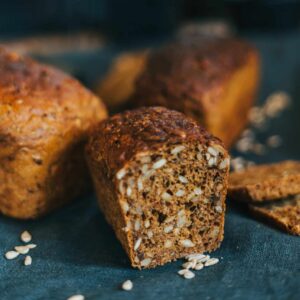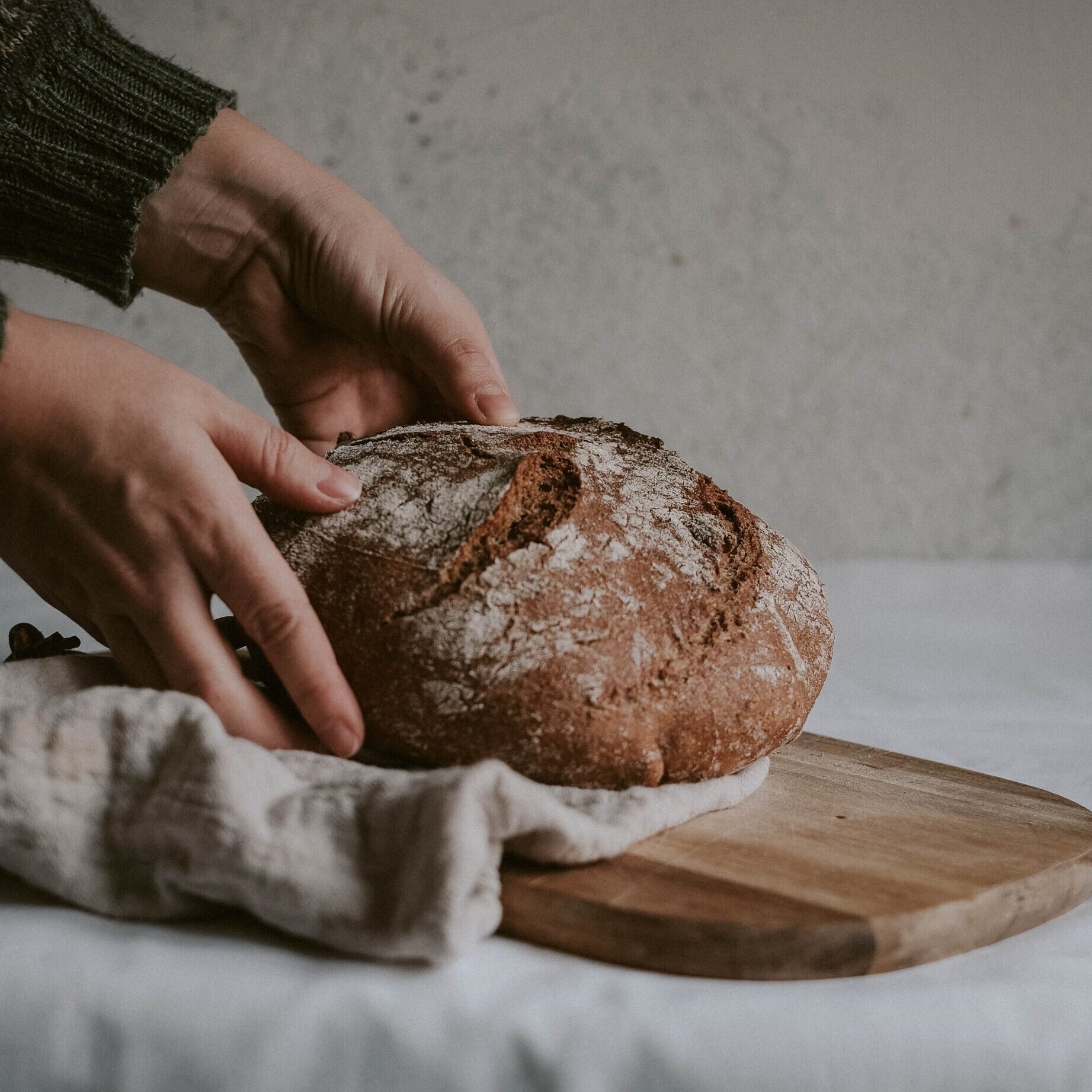Are Low Inflammation Grains Real?
I am sure you have heard me talk about my struggles with digestion after a stressful event in my life. For years I had been eating the Weston A. Price diet, where grains are “properly prepared,” as they call it. But I fell from this when time was short and stress was high. Now, with improved digestion, I am back on the horse with these healthier grains and am happy to share some easy ways to make grains be nicer to you.
See this post on the Weston A. Price Diet, “Do you Know the Healthiest Diet for You?”

Yes, eating grains can be healthy, but they may also cause inflammation in your gut and joints, for example, headaches, fatigue and stubborn weight. By reducing the amount of difficult-to-digest grains, you can make an effort towards more excellent digestive health and overall well-being. So, if you’re looking for ways to enjoy bread and other grain-based foods without sacrificing nutrition or digestive health, here are 4 things you can do to make these healthier.
1. Ancient low inflammation grains
LOW INFLAMMATION EINKORN WHEAT – The ancient grain with superfood benefits
With its unique flavor, nutritional properties, and ancient history, einkorn wheat has quickly become popular among health-conscious eaters. Also loaded with fiber, protein, and essential vitamins and minerals, this ancient grain offers numerous health benefits that make it worth trying.
What is einkorn wheat?
Einkorn wheat is an ancient wheat that has not been modified from its original form and was the type of wheat used by early man. It is one of the oldest varieties of cultivated cereal, dating back more than 7,000 years ago. And, unlike modern varieties, einkorn has a much lower gluten content, so it is okay for many who have trouble digesting gluten.
Nutritional benefits of eating einkorn wheat
Also, Einkorn wheat is rich in fibre, proteins and minerals like iron, magnesium, zinc and phosphorous. And it is also high in antioxidants, helping to protect the body against cell damage. Einkorn wheat is also a great source of B vitamins which play an essential role in energy production, metabolism and synthesis of hormones. Additionally, einkorn wheat has a lower glycemic index – meaning it releases sugar slower into the bloodstream – making it a better option for those with blood sugar related conditions. Stable blood sugar levels reduce cravings and promote weight loss.
The low gluten levels make it easier to digest
Einkorn wheat contains significantly lower levels of gluten than modern varieties of wheat. This makes it easier to digest. Additionally, because einkorn flour consists of smaller molecular structures, it can help reduce digestive discomfort associated with gluten consumption in those who do not have celiac disease but may still be sensitive to the protein. And eating less gluten can also improve energy levels and more restful sleep.
Einkorn wheat uses
So, you can incorporate it into your recipes as a replacement for regular wheat flour or as an alternative in grain dishes like risotto and pilafs. I find it works as a one-for-one regular wheat flour replacement. But einkorn absorbs liquids slower than modern-day wheat, so allow some time for it to rest in liquid. Also, the dough will be sticky instead of smooth and elastic, and less mixing time is needed.
Find einkorn wheat berries and flour at myyl.com/christie-kelemen.
LOW INFLAMMATION BLACK RICE
Black rice, also known as forbidden rice or Emperor’s Rice, is becoming popular due to its numerous health benefits. It has a nutty flavor and a chewy texture. Also, it is rich in antioxidants and dietary fiber and contains potent compounds that can help reduce inflammation, improve heart health, and more. I use it anywhere I would use regular rice.
Reduce inflammation and regulate blood sugar
Eating black rice can help reduce inflammation and improve heart health. It’s a rich source of anthocyanins, natural compounds that act as powerful antioxidants. Antioxidants fight free radicals and help to improve overall health by combating cell damage, reducing inflammation and preventing chronic illnesses. According to Zhimin Xu, PhD, “Just a spoonful of black rice bran contains more health-promoting anthocyanin antioxidants than are found in a spoonful of blueberries, but with less sugar and more fiber and vitamin E antioxidants.” (1) Additionally, it contains up to three times the amount of dietary fiber as compared to white rice, which can help maintain healthy digestion and regulate blood sugar levels.
2. Resistant starch reduces inflammation of grains
You may not be familiar with resistant starch, but it is a dietary fiber with many health benefits and is in many foods you already eat. Resistant starch is a type of starch found in some simple foods that earns its name because it is resistant to digestion in your small intestine. This means that it makes it to your large intestine, gives a boost of health to your friendly gut flora, and does not raise glucose levels. And consuming foods that contain resistant starch can improve digestion, promote weight loss, increase energy levels, and reduce the risk of chronic disease. Further, you can find resistant starch in oats and barley (as well as plantains and green bananas, beans, peas, and lentils). Also, you can create resistant starch in rice (and potatoes) by cooking and cooling them.
Weight loss benefits of resistant starch
And activating the good bacteria in your gut with resistant starch can help increase your metabolism and kickstart weight loss. Studies have found that individuals who consume diets higher in resistant starches tend to have less body fat than those who do not. This is due to the effects that resistant starch has on reducing appetite and cravings, as well as slowing down digestion and reducing the absorption of calories from carbohydrates.
Tip: Make a large batch of rice at the beginning of the week, refrigerate it and eat some each day to get resistant starch.
For more weight loss tips read this post, 10 Healthier Habits to Easily Lose Weight.
3. Soaking and sprouting to get lower inflammation grains
Soaking Grains to lower inflammation
First, soaked grains are a type of food created by soaking uncooked grains in water for an extended period of time before cooking. This process breaks down the grains’ regular starches. These regular starches in grains are polysaccharides, long chains of glucose molecules hooked together. If grains are soaked (or sprouted or soured), they are easier to digest because the polysaccharides are somewhat broken down into individual glucose molecules.
Also, grains contain antinutrients such as phytates which bind to minerals such as calcium, iron and zinc, preventing proper absorption into our bodies. But again, when grains are soaked (or sprouted or soured) these antinutrients are largely neutralized. So, with proper preparation, grains can be made more digestible and with more nutrient absorbability. Soaking also significantly reduces the cooking time—grains soaked overnight will cook much faster than those that haven’t soaked!
But ensure you discard the water the grain has soaked in and rinse thoroughly before cooking. Overnight oats are a popular recipe, but it leaves the oats in their soaking water. You’ll want to discard this water to get rid of the antinutrients that leach into the water.
Use Probiotic Foods to Pre-Digest Grains
Second, fermented foods that are rich in probiotics can also pre-digest grains. Yogurt and kefir are among the best sources of probiotics since they contain bacteria that digest carbohydrates, making the food easier to digest. So, add a spoonful of live culture yogurt or kefir while soaking your grains. The probiotics will help break down complex carbohydrates, reducing your body’s workload. An acid added to the water also aids in predigestion.
How to Soak Grains
Third, here are the details of how to soak grains. Be sure to rinse the grains thoroughly before placing them in water with a teaspoon of a probiotic or acidic medium such as lemon juice or apple cider vinegar per cup of grain. Then soak the desired amount of grains for about 8-12 hours or even 24 hours. Warm water also increases the soaking properties. After this time has elapsed, drain and discard all of the soaking liquid. Cooking soaked grains should take around 15 minutes or less. Enjoy your perfectly prepared grains!
Oatmeal, old-fashioned or oat groats, soaked the night before cook up in minutes the following morning.
Sprouting Grains to reduce inflammation
Sprouted grains, grown in a damp medium and frequently rinsed, like the beans grown on wet paper towels in elementary school until a sprout forms, are loaded with nutrients, including vitamins, minerals, amino acids, proteins and enzymes that are otherwise inactive in unsprouted grains. Sprouting also increases the bioavailability of these nutrients. Sprouted grains have similar benefits to soaked grains.
Purchase ready-made sprouted Whole Grains and Breads
But the easiest way to get sprouted grains into your diet is to buy sprouted bread at your grocery store. Likely you will find it in the freezer section. I like the Central Market Sprouted Breads best, especially the cinnamon raisin variety.
Your grocery store or health food store carry already sprouted (and then dried) oats, brown rice and quinoa.
4. Sourdough Bread

I have a profound affection for sourdough bread. For years I cultivated a sourdough starter and made my own delicious bread. Long fermented (12-24 hours) is the ultimate way to transform and improve a grain.
Sourdough bread has been around for centuries, yet few people know about all the nutritional benefits it holds.
What Is Sourdough Bread?
Sourdough bread is made from a mixture of flour, water and natural starter or “mother” culture. This combination ferments over time, creating sourdough bread’s signature sour taste and texture. The fermentation process also helps activate naturally occurring beneficial enzymes in the flour, improving its digestibility and nutrient absorption.
Sourdough benefits for digestion and gluten sensitivity
Long-fermented sourdough bread is an excellent option for those not tolerating wheat products well.
However, you may need to make your own to control the length of the fermentation process. Additionally, sourdough contains prebiotics which promotes a healthy gut environment by providing food for helpful bacteria in your intestinal tract. This can help keep your digestive system functioning properly and reduce the risk of gastrointestinal issues.
Long fermented sourdough bread
Long-fermented sourdough bread has all the nutritional benefits of its short-fermented counterparts and is easier to digest. As the fermentation process continues over a longer period of time, more beneficial compounds are released which make it easier to break down and extract the necessary nutrients from the bread. This makes long-fermented sourdough bread an ideal choice for those who have digestive issues or who may be gluten intolerant. Michael “Pollan hypothesizes that the speeding up of the bread-making process for mass consumption has so radically altered what we know as bread in the last century that it’s no longer as easily digested.” (2)
Are low inflammation grains real? Conclusion
Yes, eating grains can be healthy, but they may also cause inflammation in your gut and joints, for example, headaches, fatigue and stubborn weight. By reducing the amount of difficult-to-digest grains, you can make an effort towards more excellent digestive health and overall well-being. So, if you’re looking for ways to enjoy bread and other grain-based foods without sacrificing nutrition or digestive health, here are 4 things you can do to make these healthier.
- Try ancient einkorn grains or black rice.
- Eat grains with resistant starch.
- Sprout or soak grains to reduce inflammation.
- Make or buy sourdough bread.
And start enjoying grains again with less trouble and better health!
This blog post is for informational and educational purposes only. It is not intended to treat any health condition or to be prescriptive for anyone. Always be sure to work with your healthcare practitioner before making any changes.
(1) News release, American Chemical Society. Black rice rivals pricey blueberries as source of healthful antioxidants – American Chemical Society (acs.org), 2010 National Meeting of the American Chemical Society, Boston, Aug. 22-26, 2010.
(2) Could Sourdough Bread be the Answer to the Gluten Sensitivity Epidemic? | Mayo Clinic Connect
Get on the list to receive The Easy Anti-Inflammatory Newsletter for all the up-to-date information about reducing inflammation and improving gut health below. You’ll also receive your 9 Healthier Habits for a Healthy You cheat sheet.






